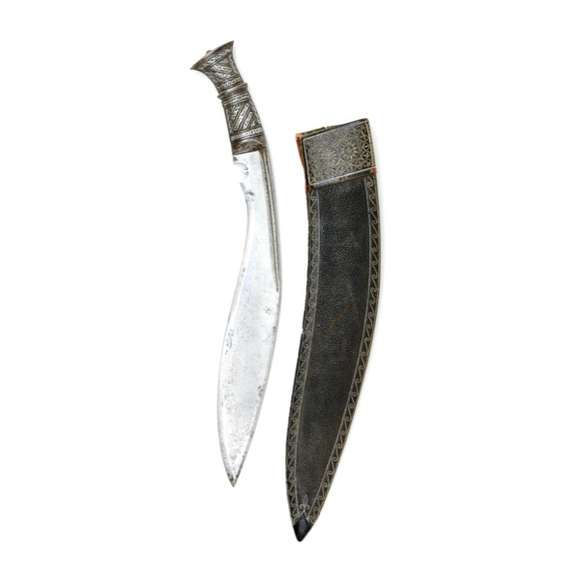An understated, elegant khukuri of substantial proportions with fine layered blade.

Sheathed 88.5 cm
Sword 75.5 cm
58 cm
Base 5.5 mm
Middle 3.4 mm
5 cm from tip 2 mm
Base 24 mm
Middle 21 mm
5 cm from tip 18 mm
573 grams
Brass, copper, silver, and various metal alloys
Nguyễn dynasty
Vietnam
Late 19th - early 20th century
From a French collection
Description
A fine and very rare Vietnamese ceremonial straightsword, called kiếm (劍). Such swords were carried by Nguyễn dynasty officials as a sign of rank.
This particular example stands out because it is of an all-metal construction. It has a brass blade, of the geometry and proportions of a proper fighting blade of this type. It has double grooves on either side, and engravings near the base and the tip.
The all-metal hilt features a copper alloy grip section with silver inlaid longevity symbols. It has a silver guard, pommel and ferrules. The guard and pommel show a dragon that is eating a tablet. Often in Vietnamese art, these tablets carry a stylized longevity character which in this case is only barely visible as most is in the dragon's mouth.

The scabbard is made of a copper rich alloy base, inlaid with flowers in silver, brass and other alloys. It has the three traditional scabbard mounts that a wooden scabbard would have, all made of silver and decorated with dragon designs in relief.
Comparable examples
Such all-metal ceremonial swords are extremely rare. In 2017, I had an all-metal gươm with a captured French blade in it. I also had an otherwise normal but very finely executed ceremonial gươm with a brass blade. This is the first kiếm in the style that I am aware of.

All-metal gươm with captured French blade.
Sold by Mandarin Mansion in 2017.

Fine ceremonial gươm with brass blade.
Sold by Mandarin Mansion in 2020.

Nguyễn Năng Quốc, Governor of Thai Binh, northern Vietnam, with two high-ranked officials in front of Thai Binh provincial palace.
Circa 1920. Photographer unknown.






















With iron, silver overlaid hilt. Its associated scabbard features fine quillwork.
Collected by a Russian prince from the hill peoples of central Vietnam in 1892.
This peculiar sword was used by the Garo people of Assam for fighting, clearing the jungle, and animal…






